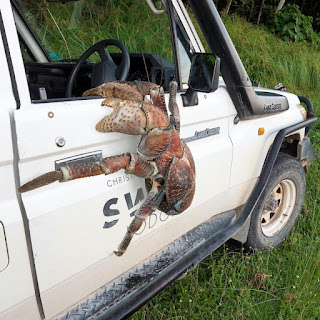Question: Have
you ever tried to crack open a coconut? Using just your hands? No machete, no
hammer and chisel, no quarter-stick of dynamite, just good ol’ grip strength
and the will to succeed? Well, it’s damn difficult. Unless, that is, you are a
member in good standing of the hermit crab species Birgus latro, colloquially known as the coconut crab. Among
these stalwarts, opening coconuts is but the work of a moment.
Coconut crabs
inhabit islands in the central Pacific and Indian oceans. They are known
primarily for two traits. First, they can easily open and dine on the meat of
coconuts, and second, they are absolutely gigantic. Some lesser known facts
about these plus-sized crustaceans: They can climb trees; they do not partake
exclusively of coconuts; they have a habit of stealing stuff; they detect
scents with mammal-like precision; and certain superstitious people believe
that eating coconut crab works as an aphrodisiac. (It doesn’t. At all. In any
way. Aphrodisiacs are in your head. You could make pencil erasers aphrodisiacs
if you decided to. Stop killing animals for dipshit reasons.)
("Hey, I'm walkin' here!")
Anyway, moving
on. Exactly how big is a coconut crab? In essence, the answer is A Whole Lotta
Big. They are so big that they freaked out Charles Darwin when he first saw
them. Coconut crabs are the largest arthropods (lobsters, spiders, scorpions,
etc.) living on land. From leg tip to leg tip, a fully mature coconut crab can
be three feet across, and can weigh up to 10 pounds. Unverified reports claim
that their bodies alone can measure up to three feet in length.
Their front
legs, the ones with the enormous pincers at the ends, are very strong, strong
enough that coconut crabs are able to lift nearly 65 pounds – or you know, your
average third-grader. Part of their lifting ability is because they possess a
grip strength of 3,300 newtons. That’s 10 times stronger than ours, and surpasses
the bite force of many land animals. A researcher named Shinichiro Oka was
pinched by a coconut crab, and said of the experience: “While it was only a few minutes, I felt
eternal hell.” They don’t go out of their way to attack humans, but if you back
one into a corner it is likely to take umbrage, and you might end up with fewer
fingers than you had when you initiated the conference.
("You want claws? I got claws for ya...")
Because they
have evolved so much raw power, coconut crabs are perfectly suited for eating
their namesake fruits (coconuts are not nuts), but they are known to munch upon
various other things as well. Almost all crabs will eat carrion if it is in the
offing, and coconut crabs are no exception. Getting one’s daily vittles by feasting
on something that is just lying there ready to be feasted on is way easier than
mucking about with trees and coconuts.
("Are you the Uber guy?")
The crabs are,
however, still predators, and as such are known to hunt for eggs, baby birds,
and rodents, among other foodstuffs. They have even been observed working in
what appeared to be an almost team-like way to stalk, kill, and eat adult seagulls
and red-footed boobies. On islands where they share territory with people,
coconut crabs have molested pets and snipped apart chicken wire to get inside
amongst the hens. And, during times when groceries are hard to come by, coconut
crabs have no problem eating other coconut crabs, and if that doesn’t work out,
they will actually pinch off one of their own legs and eat that.("Okay, stop me if you've heard this one...")
Coconut crabs
live inside fallen trees, beneath rock ledges, and in underground burrows,
easily excavated with those prodigious front claws. They spend the bulk of
their time in their dens, usually coming out only at night to find some chow.
It is easy for them to hunt in the dark because they can smell with great
precision. Biologists believe that up to 40% of a coconut crab’s brain is
devoted to its sense of smell. Granted, crustaceans aren’t exactly known as Mensa
candidates, but still…From the time
naturalists first started paying attention to coconut crabs, they have told
stories about the crabs’ penchant for pilferage. Earning the nickname “robber
crabs,” they have swiped items as diverse as cooking pots and footwear. One was
even observed schlepping around a bottle of whiskey. In 2020, coconut crabs on
Christmas Island destroyed a researcher’s $6000 thermal imaging camera, and that same year an
Australian SAS officer had his rifle stolen by coconut crabs. It was found
later in the jungle, all chewed up.
("I'm prettier than you.")
These
astonishing, perplexing crabs, with their gorgeous red, blue, and purple shells,
can live up to 60 years. That means at least one coconut crab out there could
have hatched the same year I was born. The idea is exhilarating. It inspires a
feeling of connectedness with these marvels of evolution. It satisfies my biophilia.







Comments
Post a Comment
Be smart. Be nice. Be respectful.